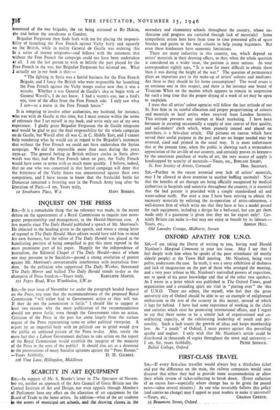SCARCITY IN ART EQUIPMENT
SIR,—In support of Mr. S. Brooke's letter in The Spectator of Novem- ber 1st, neither an approach of the Arts Council of Great Britain nor the Central Institute of Art and Design, nor even appeals through Members of Parliament have any effect on the allocation of art equipment by the Board of Trade to the home artists. In addition—what of the art students is -the scores of -municipat-ast, schools,...act-the.Aitawing classet_lat tlac
secondary and elementary schools throughout the country, whose en- thusiasm and progress are curtailed through lack of materials? Some sympathetic artists here have from time to time presented gifts of spare brushes and paints to the local schools to help young beginners. But even these kindnesses have economic limitations.
There are many industries in this country, too, which depend on artists' materials in their drawing offices, so that, when the whole question is considered on a wider issue, the position is most serious. As your correspondent rightly says, " It is now far more difficult to obtain these than it was during the height of the war." The question of permanency plays an important part in the make-up of artists' colours and mediums. Are these as they should be far home consumption? The word ersatz is an ominous one in this respect, and there is for instance one brand of Titanium White on the market which appears to remain in suspension for such a long time that the proper drying of a work of art may be open to suspicion.
I trust that all artists' colour agencies will follow the just attitude of our St. Ives firm in its careful allocation and proper proportioning of colours and materials to local artists when received from London factories. This attitude prevents any attempt at black marketing. I have been fortunate in securing occasionally a supply of tent canvas of first quality, and sail-makers' cloth which, when properly treated and placed on stretchers, is a first-class article. Old pictures on canvas which' have served their useful purpose in the past and are no longer needed may be reversed, sized and primed in the usual way. It is most unfortunate that at the present time, when the public is showing such a tremendous appreciation of the art-life of our country, and certainly proves its keenness by the consistent purchase of works of art, the very source of supply is handicapped by scarcity of materials.—Yours, etc., BORLASE SMART, St. Ives Society of Artists, Cornwall Hon. Secretary.


































 Previous page
Previous page